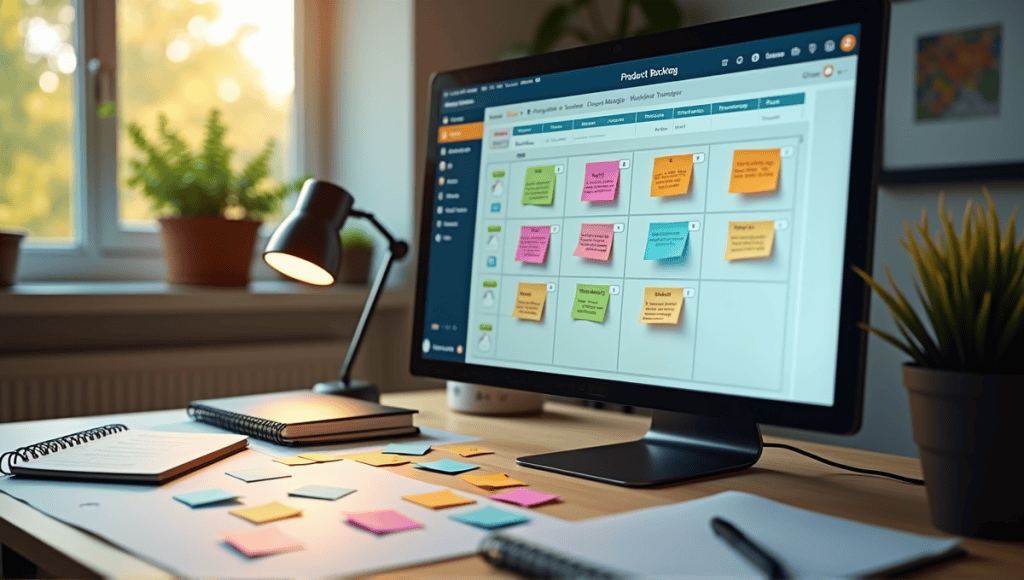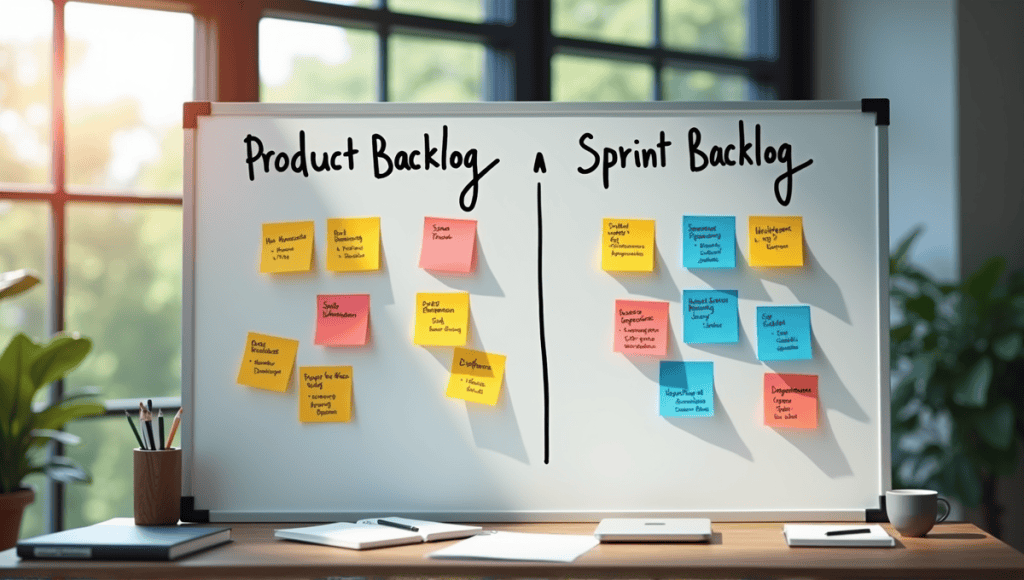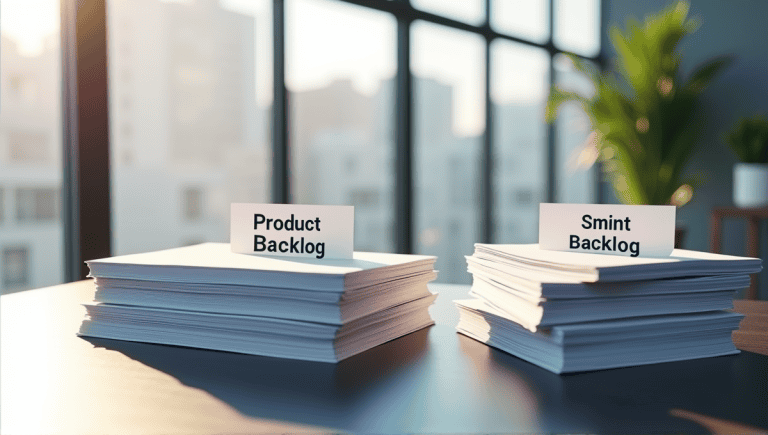Product and sprint backlogs are core concepts in Scrum, and I’ve used both of them for over 15 years of software development. The product backlog is a comprehensive list of all desired features, and the sprint backlog is a selected list of items from the product backlog for the current sprint. Knowing the distinction between the two is essential for good project management. You’ll also discover how these backlogs collaborate to ensure you’re always optimizing your development process.
Product Backlog: Definition and Purpose

The Product Backlog is an essential aspect of the Scrum framework. It’s a prioritized list of items the product needs, such as features, improvements, or bug fixes. I’ve used various Product Backlogs throughout my career, and they’re absolutely critical to the success of a project.
Product Backlogs serve as the single source of truth for the work that needs to be done. They encompass all of the product’s requirements and are continuously iterated upon. Product Owners manage these backlogs to ensure they accurately represent the current requirements of stakeholders and customers.
Backlogs share the following key characteristics:
- Always changing and evolving
- Prioritized with the most important items at the top
- Detailed enough for the team to understand
- Visible and accessible to all stakeholders
- Continuously iterated upon and updated
Product Owners are primarily responsible for managing the Product Backlog. This involves selecting the order of items and making sure the backlog is up to date. Product Owners work closely with stakeholders to understand what they want and then translate those items into the backlog.
In my experience, Product Backlogs are living, breathing documents. They need constant love and attention to ensure they remain accurate and valuable to the project.
Sprint Backlog: Definition and Purpose
The Sprint Backlog is the second backlog, and it’s a plan for how to achieve the Sprint Goal and deliver the Sprint Increment. I can’t stress enough how important a well-maintained Sprint Backlog is for keeping the team focused and productive.
Sprint Backlogs are created at the beginning of each Sprint and include the selected Product Backlog items and a plan to deliver them. They are owned by the Development Team, and they manage them by updating them daily as needed to deliver the best outcome of the Sprint.
The following are the main characteristics of Sprint Backlogs:
- A very detailed plan for current sprint
- Owned and managed by the Development Team
- Updated daily to meet the Sprint Goal
- Visual representation of the team’s plan
- Contains only those items the team plans to deliver in the current sprint
Development Teams maintain the Sprint Backlog. They decide how to accomplish the selected Product Backlog items and deliver the value. This autonomy allows teams to self-organize and ensure that the work will be complete.
Throughout my career optimizing Sprint Backlogs has been a key lift in improving team performance and the outcome of the Sprint.
Comparing Product Backlog and Sprint Backlog

The Product Backlog and the Sprint Backlog are two different things in Scrum. Knowing the distinctions between the two is essential to effective project management. Here’s a comparison from my own experience:
| Aspect | Product Backlog | Sprint Backlog |
|---|---|---|
| Scope | The entire product | A single Sprint |
| Owner | Product Owner | Development Team |
| Time horizon | Product lifecycle | Duration of a single Sprint |
| Level of detail | Varies | Very detailed |
| Flexibility | Very flexible | Less flexible |
The Product Backlog informs the Sprint Backlog. The team selects items from the Product Backlog during Sprint Planning and moves them into the Sprint Backlog. This relationship makes the connection clear.
The Product Backlog spans the entire product lifecycle. It’s constantly changing with new items added and priorities adjusted. In contrast, the Sprint Backlog remains static for the duration of the Sprint, which generally lasts 1-4 weeks.
The level of detail is another key difference. Product Backlog items are often high-level and describe work the team won’t tackle for a while. However, the Sprint Backlog items are broken down into specific tasks to complete during the Sprint.
Flexibility is also markedly different between the two. The Product Backlog is highly flexible and constantly changing. The Sprint Backlog is relatively inflexible, only changing as necessary to achieve the Sprint Goal.
Product Backlog Management
The Product Owner is responsible for Product Backlog management. Product Owners need to have a deep understanding of the product vision, market trends, and customer needs. In my experience, effective Product Owners are great communicators and great decision-makers.
Prioritization is one of the key Product Backlog management activities. I’ve successfully used the following prioritization techniques:
- Value versus effort mapping
- MoSCoW (Must have Should have Could have Won’t have)
- Weighted Shortest Job First (WSJF)
Backlog refinement is the process of adding necessary detail, estimates, and order to Product Backlog items. You can typically expect this process to consume about 10% of the Development Team’s capacity.
Stakeholder involvement is critical to Product Backlog management. Regular review sessions and feedback ensure the Product Backlog is in line with stakeholder expectations and business objectives.
Sprint Backlog Management
Development Teams own Sprint Backlog management. They build the Sprint Backlog and update it throughout the Sprint. By giving teams ownership of the Sprint Backlog, they feel more empowered to manage their work effectively.
The Sprint Backlog is created during the Sprint Planning meeting. Teams take items from the Product Backlog and figure out how they’ll deliver them. This plan then becomes the initial Sprint Backlog.
Teams often update the Sprint Backlog daily. They change the plan as they make progress and learn new things. Updating the Sprint Backlog daily is another technique for keeping focus on the Sprint Goal.
A burndown chart is a great way to track progress on the Sprint Backlog. A burndown chart is a visual of remaining work, and it also provides:
- An early indicator of problems
- Insights into team velocity
- Data to discuss in a Sprint retrospective
In my experience, effectively using a burndown chart makes a huge difference in team performance and Sprint results.
Backlog Items and User Stories
Backlog items in both the Product Backlog and Sprint Backlog are often user stories. User stories are brief, simple descriptions of functionality from the end user’s perspective. It’s taken me years to master the art of writing good user stories.
A good user story meets the INVEST criteria:
- Independent
- Negotiable
- Valuable
- Estimable
- Small
- Testable
Estimating effort on backlog items is important for planning. Most teams use Planning Poker or a similar consensus-based estimation technique that I find works quite well.
Acceptance criteria are essential for backlog items. They define when a user story is “done” and how it should work. Clear acceptance criteria help prevent people from making mistakes, and help ensure high quality deliverables.
Common Misconceptions about Product and Sprint Backlogs

There are a few misconceptions about the Product Backlog and Sprint Backlog. Here are some of the most common misconceptions I’ve come across:
- Myth: Only the Product Owner can add to the Product Backlog.
Reality: Anyone can add items to the Product Backlog. - Myth: The Sprint Backlog cannot be changed once the Sprint begins.
Reality: The Sprint Backlog can be changed if it helps achieve the Sprint Goal. - Myth: Every item in the Product Backlog must be fully fleshed out.
Reality: Items further down in the Product Backlog are less fleshed out.
Both backlogs are living documents. They change as the team discovers more about the product and its users. The ability to change both backlogs is a key benefit of the Scrum framework, enabling teams to adjust to new requirements and priorities.
In Closing
The Product and Sprint Backlogs are essential concepts in Scrum. They enable teams to prioritize work, structure tasks, and ensure value is delivered. Managing these backlogs properly is one of the most important things you can do to ensure successful project results. Just keep in mind the Product Backlog is a dynamic document that changes as the project progresses.
The Sprint Backlog identifies immediate work. Both backlogs need ongoing care and improvements. Understanding and mastering these ideas will level up your Scrum expertise and results.






